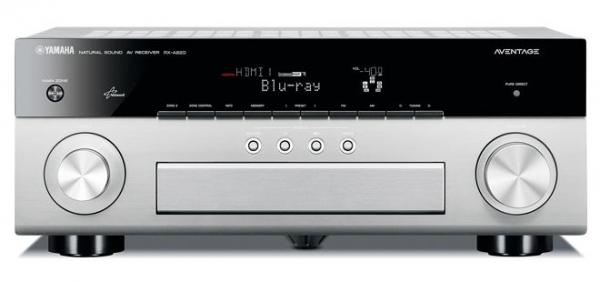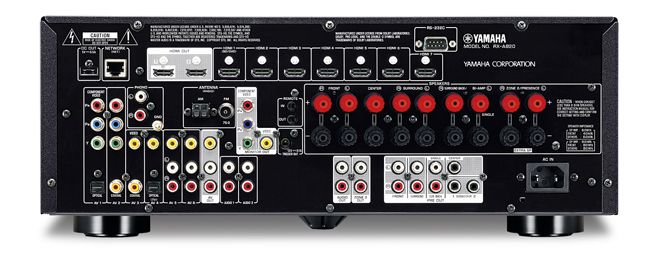Yamaha RX-A820 review

Occupying the lowest rung of Yamaha's elite 'Aventage' range, the RX-A820 is a versatile beast with DSPs galore (an area where Yamaha has a rich history), a claimed 7 x 130W of amplification at your disposal and no fewer than eight HDMI ports. With its £850 price tag it's aimed at those who want something more than just a basic AVR.
One of the HDMI sockets is located on the unit's front panel, behind a flap that also hides various inputs and controls. With this flap in its 'up' position, the overall look of Yamaha's mid-ranger is one of uncluttered smartness. It's available in both black and silver.
The Aventage models have, according to Yamaha, been bestowed with 'unparalleled attention to detail in design, engineering and fabrication', in a pursuit of improved sound quality. Of course, these basic design philosophies - a chassis designed to minimise vibration, optimised internal layout and the painstaking selection of components - are also being implemented, in one form or another, by the competition's designers, but the Yamaha does stand out by virtue of its fifth foot, centrally located on the unit's base.
Known as the A.R.T. (Anti-Resonance Technology) Wedge, it provides extra chassis support and damps any vibrations that could impair performance. A notorious offender here would be the mains transformer, which is quite compact for a component that has to sustain all that power. Indeed, the RX-A820 weighs less than you might expect.
Stocked with softwareAmong the RX-A820's software features are YPAO (Yamaha Parametric Acoustic Optimiser) auto-calibration and Android/iOS control - alternatives to a rather busy handset that, nevertheless, I feel is friendlier than recent Onkyo ones. The plethora of networked audio functions includes DLNA audio playback, an excellent internet radio client and support for the Napster subscription music service, which was added to the Aventage lineup via firmware at the end of 2012.
You can feed the Yamaha sources via composite and component video, optical/coaxial digital and stereo analogue audio as well as HDMI. 4K upscaling/passthrough and conversion of analogue to digital is handled by the latter. There's a brace of HDMI ports, allowing a projector and flatscreen TV to be run simultaneously. In audio-only terms, Yamaha has made provision for a turntable, included an FM/AM radio tuner and supported USB audio/iPods. The network connection is Ethernet only; there's no built in Wi-Fi.

In terms of speaker setup, serious movie fans will probably want a full 7.1/7.2 array. You can specify front-mounted speakers instead of the usual rear surrounds; this 'presence' mode is a Yamaha DSP special and has nothing to do with Dolby Pro-Logic IIz or DTS Neo:X, which aren't supported here. You do, however, get Pro-Logic IIx, together with Dolby Digital, DTS, their hi-def variants and seventeen more Yamaha-exclusive DSP modes.
If a 7.1 configuration isn't to your taste, you can beef-up the front-speakers of a 5.1 rig with the RX-A820's bi-amping facility. Or use the two remaining amps to drive a pair of Zone 2 speakers.
Having made the connections, it's configuration time - and what could be a frustratingly complicated experience is actually a straightforward one. The Yamaha makes use of sensibly organised onscreen menus and the aforementioned YPAO. Place the (supplied) mic in one or more positions, wait for a sequence of bursts to pour forth from your speakers, and the RX-A820's digital trickery does the rest, identifying how and where your speakers are connected before adjusting levels and EQ. It worked well in my room.
Titanic audioAs a movie machine, the RX-A820 fulfils Yamaha's usual lofty performance expectations. I span my Clash of the Titans Blu-ray via a Cambridge Azur 751BD, and the first thing I noticed is the transparency of the video switching - connecting the player directly to my TV demonstrated that the RX-A820 introduces no subjective loss of quality. A small point, but an important one.
In Chapter 9, the action heads to Argos (not the shop...) to hear Prokopion's speech to his fellow citizens: 'Why do they remain silent while we suffer?' Said suffering is conveyed well, as is the dialogue, which is always intelligible. The sharpening of swords and coughing of children is accompanied by an orchestral soundtrack perfectly balanced in an open soundstage.
Chapter 13, meanwhile, finds Perseus and his diminishing band about to face off against Medusa. Her laugh and snake-tail rattle wander in and out of the soundstage, a test of steering that the RX-A820 easily passes. However, during occasions when all channels are active, a little strain was evident at high volume levels; I'd be reluctant to use this amplifier in large listening rooms.
For stereo music playback, Yamaha offers its Pure Direct mode to preserve the last ounce of detail from your platters, the 'compressed music enhancer' to improve MP3 tracks and radio listening, plus its DSP modes. Of the latter, some, such as 7-channel stereo, bring your subwoofer into play, improving bass performance from what I felt was a little lacking. Others, like the venue-simulating Roxy Theatre and Hall In Vienna are genuinely superb, and augment live music well. Modes for movies (including Sci-Fi and the like) are less successful.
In summary, this is a worthy AVR for medium-sized rooms, with a refined character to its audio. Check it out if you can live without Dolby and DTS height processing.
HCC VERDICT
 Yamaha RX-A820
Yamaha RX-A820
Price: £850 Approx
uk.yamaha.com
Highs: Nuanced, open, movie performance; worthwhile DSP modes; neat design; decent network audio functionality
Lows: A little bass-shy in stereo mode; struggles at high listening levels; Wi-Fi requires a dongle
Performance: 4/5
Design: 4/5
Features: 4.5/5
Overall: 4/5
 |
Home Cinema Choice #351 is on sale now, featuring: Samsung S95D flagship OLED TV; Ascendo loudspeakers; Pioneer VSA-LX805 AV receiver; UST projector roundup; 2024’s summer movies; Conan 4K; and more
|






















































